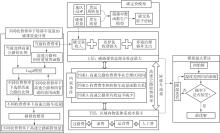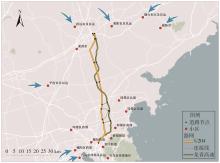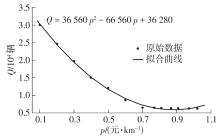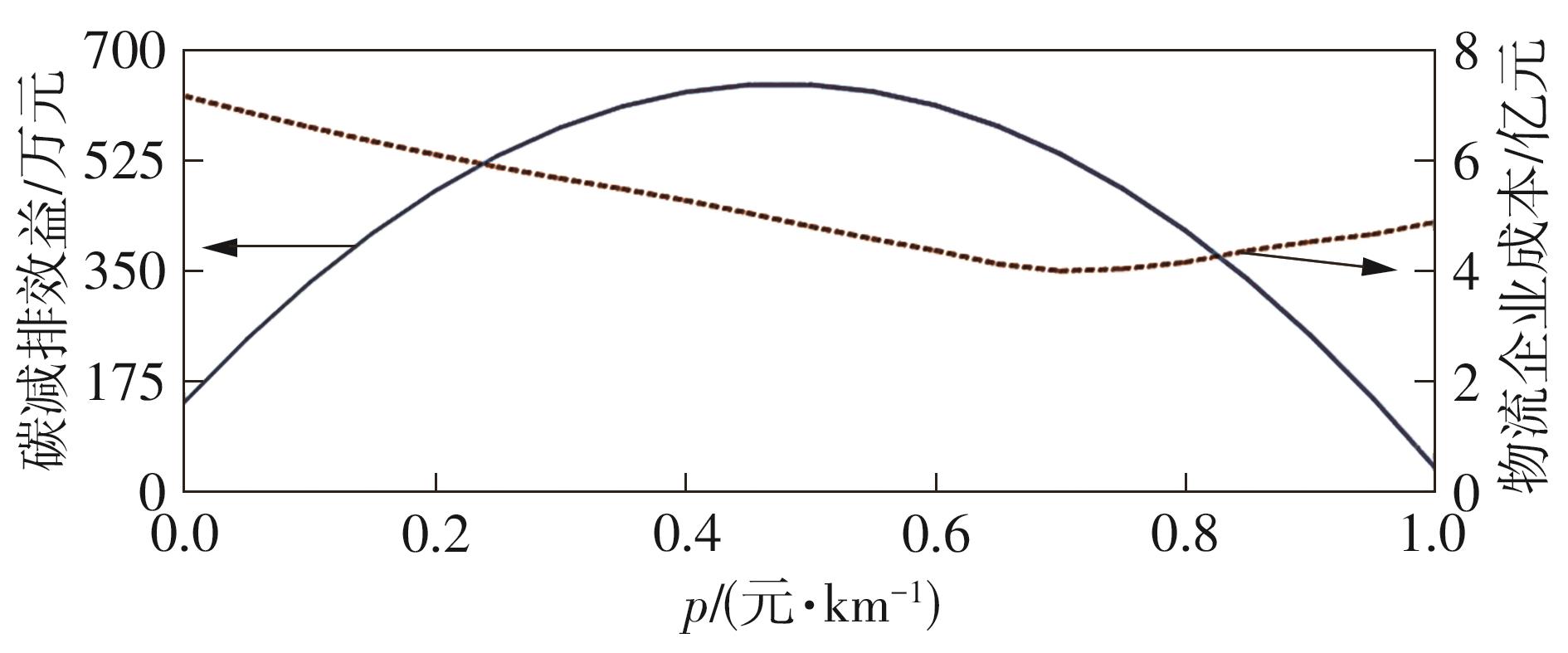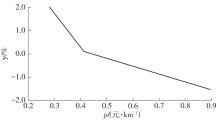Journal of South China University of Technology(Natural Science Edition) ›› 2024, Vol. 52 ›› Issue (8): 14-22.doi: 10.12141/j.issn.1000-565X.230225
• Traffic & Transportation Engineering • Previous Articles Next Articles
Differentiated Highway Toll Pricing Model Considering Carbon Emission Reduction Benefits
WANG Jiangfeng( ), LI Xiudong, SONG Zhifan, GUO Enyi
), LI Xiudong, SONG Zhifan, GUO Enyi
- Urban Traffic Information Intelligent Perception and Service Engineering Technology Research Center,Beijing Jiaotong University,Beijing 100044
-
Received:2023-04-10Online:2024-08-25Published:2024-05-17 -
About author:王江锋(1976—),男,博士,教授,主要从事智能交通、交通大数据研究。E-mail: wangjiangfeng@bjtu.edu.cn -
Supported by:the National Natural Science Foundation of China(61973028)
CLC Number:
Cite this article
WANG Jiangfeng, LI Xiudong, SONG Zhifan, et al. Differentiated Highway Toll Pricing Model Considering Carbon Emission Reduction Benefits[J]. Journal of South China University of Technology(Natural Science Edition), 2024, 52(8): 14-22.
share this article
Table 4
Value of fuel consumption factor of different types of trucks"
| 货车车型 | a | b | c | e | τ1 | τ2 |
|---|---|---|---|---|---|---|
| 货1 | 0.002 7 | -0.309 0 | 21.066 7 | 0.922 5 | 1.001 0 | 1.103 4 |
| 货2 | 0.005 7 | -0.763 4 | 47.190 0 | 1.088 6 | 0.999 1 | 1.263 8 |
| 货3 | 0.022 4 | -2.997 1 | 125.931 3 | 0.499 1 | 1.010 4 | 1.222 9 |
| 货4 | 0.014 0 | -1.765 7 | 86.405 7 | 0.908 4 | 1.000 7 | 1.148 4 |
| 货5 | 0.013 7 | -2.180 0 | 108.328 6 | 0.719 3 | 1.004 1 | 1.106 8 |
| 货6 | 0.014 6 | -2.075 0 | 92.865 6 | 1.334 3 | 0.997 5 | 1.137 1 |
Table 5
GDP, number of operating trucks, road cargo turnover and carbon dioxide emissions in Shandong pro-vince from 2015 to 2019"
| 年份 | GDP/亿元 | 营运货车 流量/万辆 | 公路货运周转量/ (百万吨千米) | 二氧化碳排放量/万吨 |
|---|---|---|---|---|
| 2015 | 55 288.79 | 94.23 | 833 415 | 134 969.80 |
| 2016 | 58 762.46 | 100.01 | 879 552 | 141 720.68 |
| 2017 | 63 012.10 | 106.69 | 962 225 | 144 953.18 |
| 2018 | 66 648.87 | 119.31 | 995 988 | 142 862.68 |
| 2019 | 70 540.48 | 125.23 | 1 007 631 | 146 013.68 |
Table 6
Log values of the individual variables in formula (9)"
| 年份 | ln Y | ln E | ln L | ln M | ln E ln L | ln E ln M | ln L ln M | (ln E)2 | (ln L)2 | (ln M)2 |
|---|---|---|---|---|---|---|---|---|---|---|
| 2015 | 10.92 | 11.81 | 13.63 | 4.55 | 161.05 | 53.70 | 61.97 | 139.54 | 185.87 | 20.66 |
| 2016 | 10.98 | 11.86 | 13.69 | 4.61 | 162.35 | 54.63 | 63.03 | 140.70 | 187.34 | 21.21 |
| 2017 | 11.05 | 11.88 | 13.78 | 4.67 | 163.73 | 55.50 | 64.34 | 141.23 | 189.81 | 21.81 |
| 2018 | 11.16 | 11.89 | 13.82 | 4.83 | 164.38 | 57.44 | 66.77 | 141.41 | 191.08 | 23.33 |
| 2019 | 11.20 | 11.88 | 13.85 | 4.83 | 164.56 | 57.41 | 66.91 | 141.20 | 191.79 | 23.34 |
| 1 | 马明娟,李强,殷文琦,等 .碳中和目标下基于GA-BP神经网络的碳交易定价模型及其模拟研究[J].生态经济,2022,38(3):40-46. |
| MA Mingjuan, LI Qiang, YIN Wenqi,et al .The study of carbon trading pricing model based on GA-BP neural network and its simulation under the goal of carbon neutrality[J].Ecological Economy,2022,38(3):40-46. | |
| 2 | ZOU J, CHEN P, FU X,et al .Does carbon trading affect the bond spread of high-carbon enterprises?:evidence from China[J].Journal of Cleaner Production,2023,417:137882/1-11. |
| 3 | 梁喜,阮实惠 .基于影子价格下的城市交通运输系统碳交易货币化方法研究[J].公路,2016,61(3):115-120. |
| LIANG Xi, RUAN Shi-hui .Research on method of carbon trading currency in city transport system based on shadow price[J].Highway,2016,61(3):115-120. | |
| 4 | 关晓轲 .基于灰色理论的碳市场交易价格预测研究[D].成都:西南交通大学,2016. |
| 5 | 周正骏 .国内外碳排放权交易价格影响因素比较研究[D].重庆:重庆交通大学,2016. |
| 6 | PIGOU A C .The economics of welfare[M].London:Macmillan,1920. |
| 7 | HENDERSON J V .Road congestion:a reconsideration of pricing theory[J].Journal of Urban Economics,1974,1(3):346-365. |
| 8 | 肖清榆,袁振洲,吴玥琳,等 .差异化收费条件下的货车出行行为研究[J].交通信息与安全,2019,37(5):133-140. |
| XIAO Qingyu, YUAN Zhenzhou, WU Yuelin,et al .A study on travel behaviors of trucks under differentiated charge[J].Journal of Traffic Information and Safety,2019,37(5):133-140. | |
| 9 | 曹一铄 .高速公路货车差异化收费定价策略研究[D].重庆:重庆交通大学,2022. |
| 10 | 李凯新 .基于碳减排收益的高速公路差异化收费定价研究[D].北京:北京交通大学,2023. |
| 11 | 温惠英,靳文舟,桂寿平 .货物运输与物流[J].华南理工大学学报(社会科学版),2001,3(3):19-22. |
| WEN Huiying, JIN Wenzhou, GUI Shouping .Freight transportation and logistics[J].Journal of South China University of Technology (Social Science Edition),2001,3(3):19-22. | |
| 12 | CHANG T H, TSENG J S, HSIEH T H,et al .Green transportation implementation through distance-based road pricing[J].Transportation Research Part A:Policy and Practice,2018,111:53-64. |
| 13 | PERERA L, THOMPSON R G, WU W .A multi-class toll-based approach to reduce total emissions on roads for sustainable urban transportation[J].Sustai-nable Cities and Society,2020,63:102435/1-16. |
| 14 | 交通运输部 .2020年交通运输行业发展统计公报[J].交通财会,2021(6):92-97. |
| Department Transportation .Statistical bulletin of transportation industry development in 2020[J].Finance & Accounting for Communications,2021(6):92-97. | |
| 15 | 蒋斌 .JXD物流公司运输成本控制研究[D].咸阳:西北农林科技大学,2020. |
| 16 | 王爽,赵鹏 .基于Logit模型的客运专线旅客选择行为分析[J].铁道学报,2009,31(3):6-10. |
| WANG Shuang, ZHAO Peng .Analysis of passengers’choice behavior for dedicated passenger railway lines based on Logit model[J].Journal of the China Railway Society,2009,31(3):6-10. | |
| 17 | 林旭坤,张扬,罗芷晴,等 .高速公路网车辆碳排放测算方法研究[J].华南理工大学学报(自然科学版),2022,50(9):22-28. |
| LIN Xukun, ZHANG Yang, LUO Zhiqing,et al .Study on measuring method of vehicle carbon emission in expressway network[J].Journal of South China University of Technology (Natural Science Edition),2022,50(9):22-28. | |
| 18 | 阮实惠 .城市交通运输系统的碳排放交易货币化模型研究[D].重庆:重庆交通大学,2017. |
| 19 | 徐建闽,首艳芳,卢凯 .基于双层规划模型的交通信号区域协调控制[J].华南理工大学学报(自然科学版),2011,39(3):95-100,106. |
| XU Jian-min, SHOU Yan-fang, LU Kai .Area coordinated control of traffic signals based on bi-level programming model[J].Journal of South China University of Technology (Natural Science Edition),2011,39(3):95-100,106. | |
| 20 | 闫丹丹 .基于两部制的高速公路收费定价研究[D].昆明:昆明理工大学,2021. |
| 21 | 张杰 .基于预售时段的高速铁路旅客票价差异化研究[D].兰州:兰州交通大学,2020. |
| 22 | 刘明磊,朱磊,范英 .我国省级碳排放绩效评价及边际减排成本估计:基于非参数距离函数方法[J].中国软科学,2011(3):106-114. |
| LIU Ming-lei, ZHU Lei, FAN Ying .Evaluation of carbon emission performance and estimation of marginal CO2 abatement costs for provinces of China:a non-parametric distance function approach[J].China Soft Science,2011(3):106-114. |
| [1] | HE Qingling, PEI Yulong, DONG Chuntong, et al. Classification and Identification of Risky Driving Behavior Based on Hybrid Strategy Improved ASO-LSSVM [J]. Journal of South China University of Technology(Natural Science Edition), 2024, 52(9): 131-141. |
| [2] | DONG Ping, HUANG Shanchao, LIU Mingbo. Optimization Approach of Inter-Regional Electricity Transmission Price Considering the Cooperative Game Strategy of Generators [J]. Journal of South China University of Technology(Natural Science Edition), 2024, 52(9): 24-34. |
| [3] | ZENG Jun, WANG Tianlun, HUANG Zhipeng, et al. Two-Stage Distributional Robust Optimization for the Expansion Planning of Photovoltaic Cluster [J]. Journal of South China University of Technology(Natural Science Edition), 2024, 52(9): 1-11. |
| [4] | LIU Mingbo, ZENG Guihua, DONG Ping, et al. Bi-Level Robust Stochastic Optimal Configuration Method for Hydrogen Energy Storage System [J]. Journal of South China University of Technology(Natural Science Edition), 2024, 52(9): 12-23. |
| [5] | LIU Weirong, ZHANG Zhiqiang, ZHANG Ning, MENG Jiahao, ZHANG Min, LIU Jie. A TT-Tucker Decomposition-Based LC Convolutional Neural Network Compression Method Without Pre-Training [J]. Journal of South China University of Technology(Natural Science Edition), 2024, 52(7): 29-38. |
| [6] | WANG Yongxing, BI Jun, XIE Dongfan, et al. Layout Optimization of Static Wireless Charging Facilities for Electric Buses by Considering Battery Degradation Characteristics [J]. Journal of South China University of Technology(Natural Science Edition), 2024, 52(6): 45-55. |
| [7] | ZHANG Yueming, LI Tianyu, JI Shuting. Influence of Cycloidal Pinwheel Reducer Parameters on Transmission Efficiency and Parameter Optimization [J]. Journal of South China University of Technology(Natural Science Edition), 2024, 52(4): 77-87. |
| [8] | WEI Peng, HE Lei, XU Weipeng, et al. Research on Topology Optimization of Compliant Mechanisms Based on Level Set Band Method [J]. Journal of South China University of Technology(Natural Science Edition), 2024, 52(3): 93-101. |
| [9] | CONG Ming, WEN Xu, WANG Minghao, et al. A GPS-Laser-IMU Fusion Mapping Algorithm Based on Iterated Kalman Filter [J]. Journal of South China University of Technology(Natural Science Edition), 2024, 52(3): 75-83. |
| [10] | LU Yiqin, HUANG Chenghai, CHEN Jiarui, et al. Time Sensitive Network Scheduling Method Based on Genetic Algorithm [J]. Journal of South China University of Technology(Natural Science Edition), 2024, 52(2): 1-12. |
| [11] | TANG Jinjun, REN Maoxin, LI Zhitao, et al. Optimization of Metro Feeder Bus Routes Based on Surrogate-assisted NSGA-II Algorithm [J]. Journal of South China University of Technology(Natural Science Edition), 2024, 52(11): 95-105. |
| [12] | LIU Ning, HUA Tianbiao, WANG Gao, CHEN Faming. A Batch Scheduling Method of Flexible Job-Shop with Partially Out-of-Ordered Execute Operation [J]. Journal of South China University of Technology(Natural Science Edition), 2024, 52(10): 51-63. |
| [13] | YANG Chunling, CHEN Wenjun, LIU Jiahui. Feature-Space Optimization-Inspired and Multi-Hypothesis Cross-Attention Reconstruction Neural Network for Video Compressive Sensing [J]. Journal of South China University of Technology(Natural Science Edition), 2024, 52(10): 9-21. |
| [14] | LU Zhimin, LI Bohang, TANG Wen, et al. Optimization Simulation of Ammonia Injection in SCR DeNO x System of Coal-Fired Power Plant [J]. Journal of South China University of Technology(Natural Science Edition), 2023, 51(8): 62-70. |
| [15] | WANG Xuewu, FANG Junyu, GAO Jin, et al. Multi-Objective Optimization Based on Improved Distribution of Solutions [J]. Journal of South China University of Technology(Natural Science Edition), 2023, 51(8): 137-148. |
| Viewed | ||||||
|
Full text |
|
|||||
|
Abstract |
|
|||||
